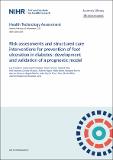Risk assessments and structured care interventions for prevention of foot ulceration in diabetes : development and validation of a prognostic model
Abstract
Background: Diabetes-related foot ulcers give rise to considerable morbidity, generate a high monetary cost for health and social care services and precede the majority of diabetes-related lower extremity amputations. There are many clinical prediction rules in existence to assess risk of foot ulceration but few have been subject to validation. Objectives: Our objectives were to produce an evidence-based clinical pathway for risk assessment and management of the foot in people with diabetes mellitus to estimate cost-effective monitoring intervals and to perform cost-effectiveness analyses and a value-of-information analysis. Design: We developed and validated a prognostic model using predictive modelling, calibration and discrimination techniques. An overview of systematic reviews already completed was followed by a review of randomised controlled trials of interventions to prevent foot ulceration in diabetes mellitus. A review of the health economic literature was followed by the construction of an economic model, an analysis of the transitional probability of moving from one foot risk state to another, an assessment of cost-effectiveness and a value-of-information analysis. Interventions: The effects of simple and complex interventions and different monitoring intervals for the clinical prediction rules were evaluated.Main outcome measureThe main outcome was the incidence of foot ulceration. We compared the new clinical prediction rules in conjunction with the most effective preventative interventions at different monitoring intervals with a ‘treat-all’ strategy. Data sources: Data from an electronic health record for 26,154 people with diabetes mellitus in one Scottish health board were used to estimate the monitoring interval. The Prediction Of Diabetic foot UlcerationS (PODUS) data set was used to develop and validate the clinical prediction rule. Review methods: We searched for eligible randomised controlled trials of interventions using search strategies created for Ovid® (Wolters Kluwer, Alphen aan den Rijn, the Netherlands), MEDLINE, EMBASE and the Cochrane Central Register of Controlled Trials. Randomised controlled trials in progress were identified via the International Standard Randomised Controlled Trial Number Registry and systematic reviews were identified via PROSPERO. Databases were searched from inception to February 2019. Results: The clinical prediction rule was found to accurately assess the risk of foot ulceration. Digital infrared thermometry, complex interventions and therapeutic footwear with offloading devices were found to be effective in preventing foot ulcers. The risk of developing a foot ulcer did not change over time for most people. We found that interventions to prevent foot ulceration may be cost-effective but there is uncertainty about this. Digital infrared thermometry and therapeutic footwear with offloading devices may be cost-effective when used to treat all people with diabetes mellitus regardless of their ulcer risk. Limitations: The threats to the validity of the results in some randomised controlled trials in the review and the large number of missing data in the electronic health record mean that there is uncertainty in our estimates. Conclusions: There is evidence that interventions to prevent foot ulceration are effective but it is not clear who would benefit most from receiving the interventions. The ulceration risk does not change over an 8-year period for most people with diabetes mellitus. A change in the monitoring interval from annually to every 2 years for those at low risk would be acceptable. Future work recommendations: Improving the completeness of electronic health records and sharing data would help improve our knowledge about the most clinically effective and cost-effective approaches to prevent foot ulceration in diabetes mellitus.
Citation
Crawford , F , Chappell , F , Lewsey , J , Riley , R , Hawkins , N , Nicolson , D , Heggie , R , Smith , M , Horne , M , Amanna , A , Martin , A , Gupta , S , Gray , K , Weller , D , Brittenden , J & Leese , G 2020 , ' Risk assessments and structured care interventions for prevention of foot ulceration in diabetes : development and validation of a prognostic model ' , Health Technology Assessment , vol. 24 , no. 62 , pp. 1-232 . https://doi.org/10.3310/hta24620
Publication
Health Technology Assessment
Status
Peer reviewed
ISSN
1366-5278Type
Journal article
Description
This project was funded by the National Institute for Health Research (NIHR) Health Technology Assessment programme.Collections
Items in the St Andrews Research Repository are protected by copyright, with all rights reserved, unless otherwise indicated.

